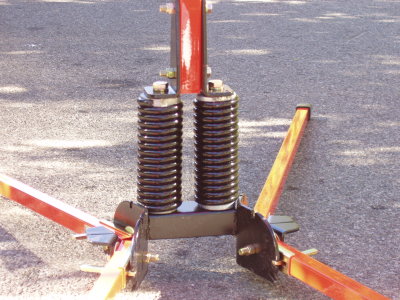|
TrafFix Devices, Inc. v. Marketing Displays, Inc.
in the Supreme Court of the United States
532 U.S. 23 (2001)
|
|
Trademark law offers no protection for the subject of an expired patent
Marketing Displays, Inc. held a utility patent on a kind of roadside construction sign with two springs incorporated into the base to keep the sign from falling over in strong winds. When the patent expired, TrafFix Devices, Inc. began manufacturing signs with the dual-spring design.
No longer having patent protection, Marketing Displays sued TrafFix for trade-dress infringement to prevent their competitor from making the dual-spring signs.
There was a problem, however, with trying to use trademark rights to pick up where patent rights left off. To receive a utility patent, an invention must be functional – that is, it must have utilitarian functionality, and not mere ornamental value. On the other hand, a product feature must be non-functional to be protected as trade dress.
TrafFix’s argument was that Marketing Displays was trying to have it both ways, claiming their dual-spring design was functional or non-functional as needed to claim a monopoly on the product.
Dual-spring inventor and Marketing Display’s president, Robert Sarkisian, claimed functionality in his patent application, saying that "two spaced apart spring connections ... prevent twisting of the sign frame." And in litigation over the patent, Sarkisian argued the functionality of the dual-springs again.
What accounted for the change of tune? Marketing Displays argued that the patent litigation concerned the "utility" of the dual-spring design, while
the trade-dress lawsuit against TrafFix concerned the "appearance" of the dual-spring design.
The Supreme Court didn’t buy it. TrafFix won a sweeping 9-0 victory. Justice Anthony Kennedy authored the opinion for a unanimous Court.
A prior utility patent, Kennedy wrote, is "strong evidence that the features therein claimed are functional. … Where the expired patent claimed the features in question, one who seeks to establish trade dress protection must carry the heavy burden of showing that the feature is not functional, for instance by showing that it is merely an ornamental, incidental, or arbitrary aspect of the device."
With regard to the dual-spring design, the Court held that Marketing Displays did not and could not overcome the strong evidentiary inference of functionality based on the dual-spring design claimed in the expired patents.
In halting the trade-dress claim, the Court warned that that there is no general prohibition against copying goods and products.
"In general, unless an intellectual property right such as a patent or copyright protects an item, it will be subject to copying." The Court went on to note that copying is often a good thing. "Allowing competitors to copy will have salutary effects in many instances."
TrafFix made sure to get a top-shelf lawyer to argue their case at the high court. Who did they hire? John Roberts. That’s the same John Roberts who, five years later, was sworn in as the Court’s new chief justice. Good choice.
About the artifact:
The Little Buster sign, pictured, was a generous donation to the Museum by TrafFix. Links:
|

